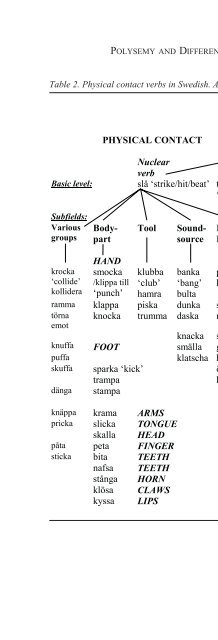Cognitive Semantics : Meaning and Cognition
Cognitive Semantics : Meaning and Cognition
Cognitive Semantics : Meaning and Cognition
You also want an ePaper? Increase the reach of your titles
YUMPU automatically turns print PDFs into web optimized ePapers that Google loves.
SITUATED EMBODIED SEMANTICS AND CONNECTIONIST MODELING 191<br />
results where the behavior of their net follows some of the steps in the learning<br />
of language by children. However, as in all kinds of modeling, they are forced<br />
to various kinds of simplifications. One is that they, as in another impressive<br />
connectionist model of “grounding” — that of Dorffner (1989), stop at the<br />
level of “single symbols”. The major conclusion from the research described<br />
in this paper is that situated embodied semantics <strong>and</strong> other similar approaches<br />
to meaning <strong>and</strong> language acquisition will st<strong>and</strong> or fall depending on whether<br />
they can provide a satisfactory account of how “symbols”, or rather words, are<br />
meaningfully combined.<br />
Acknowledgments<br />
Though I am not sure that any of the people that I would like to acknowledge<br />
would readily associate themselves with “situated embodied semantics”, I feel<br />
I need to do so anyway. If it hadn’t been for Terry Regier, who generously left<br />
his system at my disposal <strong>and</strong> performed some of the experiments together with<br />
me in Berkeley <strong>and</strong> Stockholm, there would not have been any connectionist<br />
modeling to report on. Sarah Williams gave useful comments from a developmental<br />
perspective, which was the first impetus for me to look more seriously<br />
at child language acquisition - more so since this paper had taken form. Sven<br />
Öhman provided the impulse for most of the reasoning about “creativity” <strong>and</strong><br />
was generally supportive despite disagreeing with my “solutions”.<br />
I also thank to the two anonymous referees for their insightful comments<br />
on form <strong>and</strong> content, which I have tried to address as best as I can, <strong>and</strong> to the<br />
many people who read <strong>and</strong> commented on drafts of this, perhaps a bit<br />
overedited, article.<br />
Notes<br />
1. It is controversial to what extent neural nets also display “brain-likeness” <strong>and</strong> can, thus,<br />
help answer the question of how the mind is “embodied” also in the sense of “how it is<br />
realized in the human brain”. I will not deal with this question, but I basically agree with<br />
Sampson (1987) that “when models are as successful as connectionist models appear to<br />
be in predicting observable human behavior, they establish a claim to our attention, even<br />
if the mechanisms from which they are built seem a-priori entirely implausible” (ibid<br />
:873).















